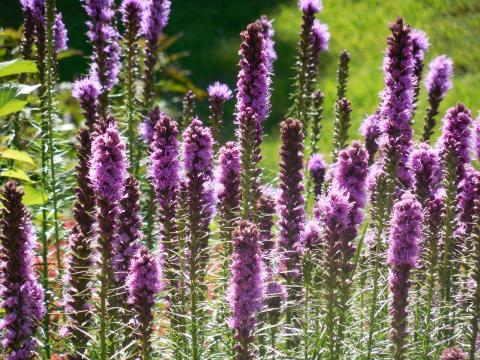Is it okay to plant a garden over a leach field?

Planting over a septic leach field (drain field) is possible if it is done with care. If you have limited space on your property where you can garden, the leach field may be the only spot for landscaping. Growing shallow-rooted plants over the drainage area is recommended because they help remove excess moisture and nutrients from the soil and reduce erosion. Although turf grass is the typical choice, a variety of other herbaceous perennials, annuals and groundcovers can be safely and effectively planted. Vegetable gardening over a leach field is not recommended.
About Septic Systems
In rural areas where city sewer lines are not available, most homes have their own septic systems that consist of a septic tank and leach field. The septic tank breaks down organic matter and separates oil, grease and solids from household waste water. The remaining effluent is discharged from the septic tank to a series of underground perforated pipes that allow the liquid to slowly drain into the soil. In a properly functioning septic system, percolation through the soil removes harmful bacteria and nutrients before the water reaches the water table.
Planting Considerations
Planting over a leach field deserves special consideration because plant roots can clog the drain pipes and potentially damage the drain field – an expensive problem to fix. Many herbaceous perennials are pretty safe options because their roots will not grow deep enough to reach the pipes. Drought tolerant species are preferred because they do not require much irrigation and their roots will not attempt to reach into the constantly saturated soil around the drain pipes. Avoid water-loving plants that are apt to try to find additional moisture. Additionally, limiting the amount of water applied over the leach field is important, because saturating the soil may reduce effluent evaporation and increase the risk of groundwater contamination.
Placing trees or shrubs over or near the leach field is risky. Woody plants have deeper roots that may clog drain pipes in relatively short order. Water-loving species are especially chancy and should be avoided, such as willow, poplar, elm, red and silver maple, birch and beech. If you simply must plant a tree, position it towards the end of the drainage line where there is less water to draw roots in the direction of the leach field. Try to consider how far the roots will spread as the tree matures. Roots will typically extend at least as far from the trunk as the tree is tall.
Before planting, it is a good idea to check the soil pH. The detergents and cleaning products that go down the drain are usually alkaline and may elevate the soil pH over time. Depending on what you want to grow, you may need to amend the soil to adjust the pH. Moreover, household effluent generally contains high levels of salt, especially if you have a water softener. Plants that can tolerate salt exposure are more likely to thrive.
Vegetable gardening over a leach field is a bad idea. Though properly functioning septic systems won’t contaminate the soil with harmful pathogens, there is no easy way to guarantee that the crops grown over a leach field will be safe to eat. Furthermore, vegetable gardeners may not be keen on growing their food plants in soil that is frequently inundated with household chemicals. Unfortunately, placing raised beds over the drainage area isn’t a good solution either. The added soil depth of the beds may inhibit evaporation and limit the effectiveness of the septic system.
Suggested Perennials
|
Astilbe
|
Astilibe species
|
|
Barrenwort
|
Epimedium species
|
|
Barren strawberry
|
Waldsteinia ternata
|
|
Beardtongue
|
Penstemon digitalis
|
|
Black-eyed-Susan
|
Rudbeckia hirta
|
|
Blanket flower
|
Gaillardia species
|
|
Blazing star
|
Liatris species
|
|
Butterfly milkweed
|
Asclepias tuberosa
|
|
Catmint
|
Nepeta racemosa
|
|
Columbine
|
Aquilegia species
|
|
Cranesbill
|
Geranium species
|
|
Daylily
|
Hemerocallis species
|
|
Dianthus
|
Dianthus species
|
|
Globe thistle
|
Echinops ritro
|
|
Goldenrod
|
Solidago species
|
|
Hens and chicks
|
Sempervivum species
|
|
Hosta
|
Hosta species
|
|
Knautia
|
Knautia macedonica
|
|
Lamb’s ears
|
Stachys byzantina
|
|
Lupine
|
Lupinus species
|
|
Moss phlox
|
Phlox subulata
|
|
Mullein
|
Verbascum species
|
|
Poppy
|
Papaver species
|
|
Purple coneflower
|
Echinacea purpurea
|
|
Russian sage
|
Perovskia atriplicifolia
|
|
Spurge
|
Euphorbia species
|
|
Stonecrop
|
Sedum species
|
|
Tickseed
|
Coreopsis species
|
|
Wild bergamot
|
Monarda fistulosa
|
|
Woodland sage
|
Salvia nemerosa
|
|
Yarrow
|
Achillea species
|
Got questions? The Ask UNH Extension Infoline offers practical help finding answers for your home, yard, and garden questions. Call toll free at 1-877-398-4769, Monday to Friday, 9 a.m. to 2 p.m., or e-mail us at answers@unh.edu.
Do you love learning about stuff like this?
SUBSCRIBE TO Granite State Gardening newsletter
Got questions? The UNH Extension Yard and Garden Infoline offers practical help finding answers for your yard and garden questions.
Call toll free at 1-877-398-4769, Monday to Friday, 9 a.m. to 2 p.m., or fill out webform.
